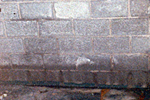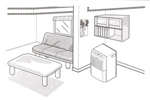For decades, thousands of satisfied homeowners have relied on The B-Dry System to solve their wet basement problems.
For more information, immediate assistance or a free estimate, select one of the options below.

Even Moisture Level Along
Bottom of Walls
Possible Causes:
Condensation: The basement area of your home is below ground level and is therefore shielded from sunshine and warm summer air. Your basement walls and floor remain colder than the walls above ground. When warmer air is allowed to enter the cooler basement area, it shrinks in volume. All the moisture contained in that air is now "condensed" into a smaller volume of air. Once the air reaches its saturation point, beads of moisture will begin collecting on cool surfaces. This is called condensation.
Solutions for Condensation: Because condensation is not water "leaking" into the basement, waterproofing will not eliminate this problem. Waterproofing will prevent additional moisture from entering the air, but you'll need to mechanically control and remove the natural humidity from the air to control this problem.

Make sure your basement's dehumidifier has a drain hose connection. Dehumidifiers with buckets or pails to collect the water will shut off once the container is full. A drain hose allows your dehumidifier to continue running in the event of higher humidity.
Try to close all doors and windows after using them to stop additional humidity from entering the basement area. This will help save electricity too.
Whether your basement leaks or not, a dehumidifier can be beneficial in keeping troublesome humidity levels down. Basement moisture control is essential in creating a healthy environment.
Walls Absorbing Moisture From Underneath - Blocks and concrete walls are porous. Capillary action or capillary attraction is a natural process that allows your basement walls to suck up water from underneath the floor.
This is also a sign that water may be lying underneath your concrete basement floor.
Solution: Install Drain Tiles Below The Floor - Drain tiles will drain and lower the water level underneath your basement floor. This requires removing a one foot wide section of the basement floor around the basement perimeter. A trench is excavated down alongside the footer for the installation of crushed stone and a drainage system.
Drain holes can be drilled into the block's hollow cores to relieve any stagnant water trapped inside. Wet walls should be sealed above and below floor level before the floor is re-cemented to its previous condition.
A drainage system installed at footer level will aid in preventing basement capillary action in the floors and walls.
The drainage system would empty into a sump well with an automatic pump to discharge any water that collects.
© 2017 B-Dry Owner's Association
RECOMMEND THIS PAGE